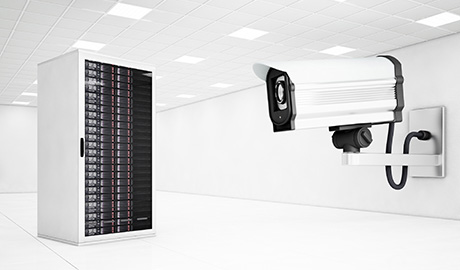Building An Effective Video Surveillance Data Infrastructure For Enhanced Storage And Performance
The video storage boom shows no signs of slowing down. The talk is not typically how much storage; but where and how to store. Locally-housed (on-premises) storage continues to be the most cost-effective, along with providing the most control over your data. However, prior to considering the storage, it is important to look at the robustness of the network, as it is a key factor in making the right decision for storage architecture. It is necessary to know if there is enough pipe to take the footage from point A to point B.

For Enhanced Storage And Performance
The video storage boom shows no signs of slowing down. The talk is not typically how much storage; but where and how to store. Locally-housed (on-premises) storage continues to be the most cost-effective, along with providing the most control over your data. However, prior to considering the storage, it is important to look at the robustness of the network, as it is a key factor in making the right decision for storage architecture. It is necessary to know if there is enough pipe to take the footage from point A to point B.
Storage Requirements For Video Cameras
It is more than likely that the existing network was not initially designed with IP video cameras in mind. VOIP phones, perhaps; but not the IP cameras. With 1080P cameras using 2-3Mb and 20MP cameras taking 20-30Mb of network stream, it does not take many video cameras to wreak havoc on the existing network. This is why a parallel network exclusive to the video cameras is generally the best course of action.
As you start determining the storage needs, it is critical that scalability is built into the formula. We generally suggest 20% overhead availability. You certainly do not need to purchase the system that way, but just know – in advance – your options to upgrade. Ask how many additional cameras the system in its present state can handle, and how many open drive bays are available, and how many cameras per hard drive added? If the answer is none and none, then you are getting a maxed-out system with zero scalability. Buyer, beware – as many things beyond your control can change the storage requirements, even after the system has been deployed.
Longer Retention Periods For Storage
More often than ever, government and business retention regulations have come into play. Anyone selling into the Texas school system knows about SB 507, the law mandating that special education classrooms must record audio and video for a period of 180 days. No special funding was extended to offset this requirement.
But Texas schools are not the only ones faced with longer retention mandates. The U.S. Coast Guard has regulations on all commercial vessels requiring six months of retention. Payment Card Industry (PCI) requires 90 days. In Illinois, medical marijuana fields and dispensaries WERE 30 days of retention. Overnight and without warning, this was changed to 90 days, and they had thirty days to comply or face fines. The list goes on and on.
With both last minute changes and unforeseen regulations in mind, it is imperative to have storage flexibility. In every situation, the fix could be as easy as adding a hard drive or two – a much better and less costly solution than needing a new server. Keep in mind the analytic capabilities within the stored footage. More and more corporations and organizations are utilizing video analytics as they do their Business Intelligence software, which requires an even longer period of time in order to view that data.
Make it a priority that your server is purpose-built to run with the video software of your choosing. There are nuances within each of the major video management software companies that make them write differently to the disks. The system needs to be built to support that particular software for maximum performance per their disk allocations. One size certainly does not fit all!
Durability Of Recording Servers

Storage capabilities within the server are important, but bandwidth capabilities are the key. These days, anyone could build a 100+TB server. All you really need is a box and drive bays. But without the ability to process the data to the hard drives and simultaneously send that out to the viewing station or stations, the storage serves little purpose other than driving up the cost. The ability of the video server to ingest large amounts of bandwidth is more vital to managing and recording the video than the storage capacity of the unit.
If the video recording system cannot manage 500Mbps throughput, it really has no business being called an enterprise video server; it’s just a server running video. Or an expensive DVR.
Case in point, use 125 x 1080P cameras at 15fps an example. Regardless of the retention time, be it one day or thirty, the necessary system bandwidth stays consistent at 414Mbps. For thirty days of storage, it’s roughly 67TB of RAID5 useable storage or 84TB of total storage. The storage part is easy, just need enough drive bays and hard disks. The major hard disk manufacturers have done their part to make those affordable. Focus on the bandwidth and throughput capabilities within the server. It really is that critical.
Lastly, durability needs to come into the equation. The server could very well have an on-site warranty. However, if the unit is crashing every other day, and the integrator needs to roll a truck each time after the service call, then you have cameras that are also not recording every other day alongside of it. In the end, the “included” warranty ends up costing money for labor and possibly the reputation with the customer.
This could also result in a liability to the business or the integrator. A few years back, at a major league baseball stadium, a couple was mugged in the parking lot after the game, underneath a video surveillance camera. Unfortunately for them, the recording server was not functioning, thus nothing was recorded. More unfortunately for the park, they were sued under the argument that having the video camera gave the couple the sense of security; although it turned out to be a false sense of security. Having the system consistently running should be the expectation. Consider the warranty more of an insurance policy SHOULD the server have an issue, not WHEN.
Building the proper infrastructure regarding the network and within the video recorder as it relates to bandwidth, scalability, and durability, will ensure success in your video surveillance recording. Not only for today, but for five years from today… and beyond.
View the whole story at sourcesecurity.com.

